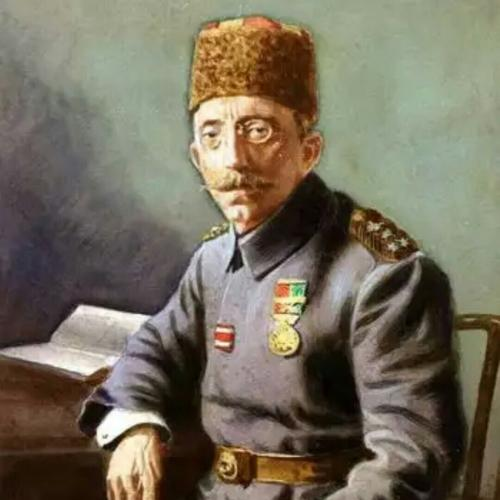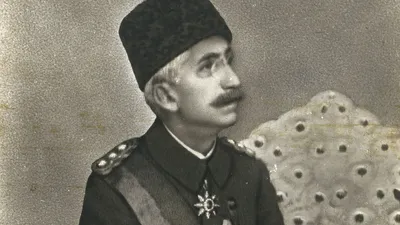
Mehmed Vi Biography: Parents, Spouse, Children, Instagram, Death, Age, Net Worth
Mehmed VI Vahideddin, referred to as Şahbaba by the Osmanoğlu family, was the final Sultan of the Ottoman Empire and the second-to-last Ottoman caliph.
His reign lasted from July 4, 1918, until November 1, 1922, when the Ottoman sultanate was abolished, paving the way for establishing the Republic of Turkey on October 29, 1923.
Trending Now!!:
Profile
- Full Name: Mehmed VI Vahideddin
- Stage Name: Şahbaba
- Born: January 14, 186
- Date of death: May 16, 1926 (Aged: 65 years)
- Birthplace: Dolmabahçe Palace in Istanbul, Türkiye
- Nationality: Ottoman
- Occupation: Former Sultan of the Ottoman Empire
- Height: Unknown
- Parent: Sultan Abdulmejid I ,Gülüstü Hanım.
- Siblings: Mehmed V, Abdul Hamid II, Süleyman Efendi, Murad V, Seniha Sultan, Mehmed Burhaneddin Efendi, Mediha Sultana
- Spouse: Nazikeda Kadın (m. 1885–1926), İnşirah Hanım Efendi (m. 1905–1909), and Nevvare Hanım (m. 1918–1924)
- Children: Şehzade Mehmed Ertuğrul, Rukiye Sabiha Sultan, Fatma Ulviye Sultan, Fenire Sultan
- Relationship: Married
- Net Worth: Unknown
Early Life And Education
Mehmed VI Vahideddin was born on 14 January 1861 at Dolmabahçe Palace in Istanbul, Türkiye, to Sultan Abdulmejid I and Gülüstü Hanım.
After his mother’s death when he was four, he was adopted by Şayeste Hanım, another of his father’s consorts.
Through his father’s other wives, he had many half-siblings, including Mehmed V, Abdul Hamid II, Süleyman Efendi, Murad V, Seniha Sultan, and Mehmed Burhaneddin Efendi; however, his only full sibling to survive into adulthood was Mediha Sultana.
Growing up in the Ottoman Imperial Harem, Mehmed VI was cared for by nannies, maids, and private tutors.
His early education was tailored within the palace, and he later continued his studies at Fatih Madrasa, where he focused on literature, music, calligraphy, and the naskh script. A member of the House of Osman, he was a devout follower of Sunni Islam.

Career
Mehmed VI Vahideddin ascended the Ottoman throne on July 4, 1918, following the death of his half-brother, Mehmed V, becoming the 36th and final Sultan of the Ottoman Empire.
His reign began during a critical juncture, as the empire was in its final stages of World War I, grappling with military defeat and internal decline.
The signing of the Armistice of Mudros in October 1918 ended the empire’s involvement in the war but led to the occupation of Istanbul and other regions by Allied forces.
Hoping to preserve the empire through diplomacy, Mehmed VI pursued close cooperation with Britain and the Allies.
Still, his pro-British stance failed to shield the empire from the severe conditions of the Treaty of Sèvres, which included significant territorial losses.
Mehmed VI struggled to preserve central authority during his reign despite growing nationalist movements.
One of his most consequential decisions was appointing Mustafa Kemal Pasha to restore order in Anatolia, unaware that it would catalyze the rise of a powerful nationalist resistance.
Mustafa Kemal defied the Sultan’s accommodation policies with foreign powers, instead mobilizing a broad movement that sought to defend Turkish sovereignty and reverse the empire’s disintegration.
The dissolution of the Ottoman Parliament in December 1918 and subsequent efforts to suppress the nationalist uprising further alienated key segments of society, accelerating the decline of the Sultan’s political influence and control.
The final chapter of Mehmed VI’s rule came with the official abolition of the Ottoman Sultanate on November 1, 1922, by the nationalist Grand National Assembly.
Forced into exile, he departed Istanbul aboard a British warship, marking the symbolic and political end of the Ottoman monarchy.
The nationalist forces, led by Mustafa Kemal Atatürk, established the Republic of Turkey, formally declared on October 29, 1923.
Mehmed VI lived the remainder of his life in exile in Sanremo, Italy, where he died in 1926. His departure closed the book on over six centuries of Ottoman rule and ushered in a new era in Turkish history.
Social Media
Mehmed VI Vahideddin does not have a social media account.
Personal Life
Mehmed VI was primarily married to Nazikeda Kadın, his chief consort and wife for nearly two decades, who was regarded as the last Ottoman Empress.
They had three daughters: Münire Fenire Sultan, who died in infancy, Fatma Ulviye Sultan, and Rukiye Sabiha Sultan.
When Nazikeda could no longer have children, Mehmed VI took additional consorts in hopes of producing a male heir.
Among them was Müveddet Kadın, who gave birth to his only son, Şehzade Mehmed Ertuğrul, along with others such as Inşirah Hanım, Nevvare Hanım, and Nevzad Hanım.
While his daughters went on to marry and have descendants, his son remained unmarried and childless.

Net Worth
Mehmed VI had a modest net worth at the time of his exile. He left Istanbul with approximately £20,000, a sum that was largely lost to gambling and deceit.
Struggling financially, he was eventually forced to sell personal belongings, including medals, to meet his expenses and repay debts.
NOTICE!! NOTICE!! NOTICE!!
At TheCityCeleb, we strive to provide accurate and up-to-date biographies and entertainment news, focusing on celebrities. Our editorial team researches information from reputable sources, including interviews, official statements, and verified media.If you spot an error or have additional details, please contact us at editor@thecityceleb.com. We value your feedback and are committed to maintaining trustworthy content.
